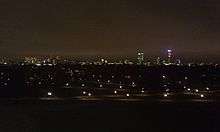Primrose Hill
| Primrose Hill | |
 View of central London from Primrose Hill |
|
 Primrose Hill |
|
| OS grid reference | TQ282838 |
|---|---|
| London borough | Camden |
| Ceremonial county | Greater London |
| Region | London |
| Country | England |
| Sovereign state | United Kingdom |
| Post town | LONDON |
| Postcode district | NW1, NW3, NW8 |
| Dialling code | 020 |
| EU Parliament | London |
| UK Parliament | Holborn and St. Pancras |
| London Assembly | Barnet and Camden |
Coordinates: 51°32′23″N 0°09′39″W / 51.5396°N 0.1608°W
Primrose Hill is a hill of 213 feet (65 m)[1] located on the northern side of Regent's Park in London, and also the name given to the surrounding district. The hill summit has a clear view of central London, as well as Hampstead and Belsize Park to the north and is adorned by an engraved quotation from William Blake. Nowadays it is one of the most exclusive and expensive residential areas in London and is home to many prominent residents.[2]
The Primrose Hill district is surrounded by the affluent areas of St John's Wood to the west, Swiss Cottage to the northwest, Belsize Park to the north, Chalk Farm to the north east, Camden Town to the east and Regent's Park itself lies adjacent to the south of the hill itself. The nearest stations to Primrose Hill are Chalk Farm tube station to the northeast and Swiss Cottage tube station to the northwest. The defunct Primrose Hill railway station sits on the railway lines that separate the Primrose Hill area from Camden Town.
Amenities of the hill include an outdoor gym known as the Hill Trim Trail, a children's playground, and toilets, all located on the south side near Primrose Hill bridge which connects to London Zoo and Regent's Park.
History


Like Regent's Park, Primrose Hill was once part of a great chase appropriated by Henry VIII. Later, in 1841, it became Crown property and in 1842 an Act of Parliament secured the land as public open space. The built up part of Primrose Hill comprises mainly Victorian terraces; indeed the area was named after Archibald Primrose, whose premiership witnessed the rapid expansion of London underground rail network London.[3]
It has always been one of the more fashionable districts in the urban belt that lies between the core of London and the outer suburbs, and remains expensive and prosperous. Primrose Hill is an archetypal example of a successful London urban village, due to the location and the quality of its socio-historical development.[4]
In October 1678, Primrose Hill was the scene of the mysterious murder of Edmund Berry Godfrey.[5] In 1792 the radical Unitarian poet and antiquarian Iolo Morganwg (Edward Williams) founded the Gorsedd, a community of Welsh bards, at a ceremony on 21 June at Primrose Hill.
Blue plaques
There are seven English Heritage blue plaques in Primrose Hill commemorating the historic personalities that have lived there.[6] The plaques mark the residences of poet Sir Hugh Clough, historian and broadcaster A. J. P. Taylor and painter William Roberts at 11, 13, and 14 St Mark's Crescent respectively, revolutionary socialist and philosopher Friedrich Engels at 122 Regent's Park Road, photographer Roger Fenton at 2 Albert Terrace, poet and novelist Sylvia Plath at 3 Chalcot Square, and poet William Butler Yeats at 23 Fitzroy Road.[6] Joan Bakewell also lives in the area.[7]
See also
References
- ↑ Mills, A., Dictionary of London Place Names, (2001)
- ↑ Knight Frank & Rutley, Londons Top 10 Expensive Areas 2011
- ↑ www.londonist.com
- ↑ Barr, Alistair, Primrose Hill, An Urban Village Examined
- ↑ http://www.pbslearningmedia.org/resource/xjf380469eng/sir-edmund-berry-godfreys-murder-made-visible-contemporary-pamphlet-1678-xjf380469-eng/
- 1 2 "Search Blue Plaques". Blue plaques search – Primrose Hill. English Heritage. Retrieved 6 September 2014.
- ↑ http://www.hamhigh.co.uk/cmlink/hampstead-highgate-express-broadway/entertainment/joan_bakewell_life_is_short_so_get_your_values_sorted_1_4262634
External links
| Wikimedia Commons has media related to Primrose Hill. |
- Primrose Hill – An Urban Village Examined by Alistair Barr, Architect & Resident (Barr Gazetas)
- Article on Primrose Hill Farmers' markets
- Primrose Hill Local Website
- Primrose Hill and Regent's Park in Literature and Music, a bibliography

